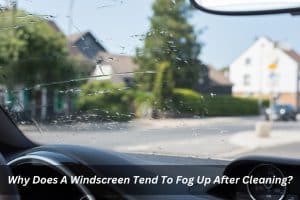Why Does A Windscreen Tend To Fog Up After Cleaning?

Ever spent time meticulously cleaning your windscreen, only to be greeted by a frustrating fog shortly after? You’re not alone. This common phenomenon can be a real pain, especially when you’re trying to hit the road. But fear not, fellow drivers! This guide will unveil the science behind windscreen fogging, explore the culprits beyond cleaning, and equip you with effective solutions to keep your view crystal clear.
Is it just you, or does everyone’s windscreen fog up after cleaning?
Believe it or not, windscreen fogging after cleaning is a widespread issue. The reason? It’s all about temperature and moisture, two elements that love to play a game of hide-and-seek on your clean glass.
What’s the science behind windscreen fogging up?
Remember that experiment in science class where you saw your breath fog up a cold mirror? The same principle is at play when your freshly cleaned windscreen turns hazy. Let’s dive deeper into the science behind this frustrating phenomenon:
- Temperature tango: Imagine air as a sponge: the warmer it is, the more moisture it can hold. Now, picture your clean windscreen as a cool ice cube. When warm, moist air meets this cool surface, it’s like squeezing the sponge – the air can’t hold all the moisture anymore. So, the excess moisture condenses onto the cold glass, forming tiny water droplets – and voila, you have windscreen fog!
- Dew Point drama: But there’s another key player: Dew Point. Think of it as the temperature at which the air becomes saturated with moisture, like a sponge that’s completely soaked. The closer the windscreen temperature is to the dew point of the air inside your car, the more likely condensation becomes. So, on a chilly morning with a high humidity level, even a slight temperature difference between the air and your windscreen can trigger fogging.
- The residue riddle: Now, the twist you mentioned. Cleaning products can sometimes be the villain in this story. Some contain ingredients that leave behind thin, invisible films on the glass. These films act like microscopic magnets, attracting water molecules and making condensation even more likely. It’s like adding extra grip to the ice cube, making it easier for the water droplets to cling on.
- Drying dilemmas: Even if you use the right cleaning product, skipping the drying step can also contribute to fogging. Tiny water droplets left behind on the seemingly clean glass provide a perfect starting point for condensation. It’s like leaving tiny puddles on the ice cube, just waiting to expand and merge into a bigger, foggier mess.
So, the next time you find yourself battling windscreen fog, remember the temperature tango, the dew point drama, and the residue riddle. By understanding these scientific factors and following proper cleaning and drying techniques, you can keep your view clear and enjoy a fog-free driving experience!
Beyond cleaning mistakes: What other factors contribute to windscreen fogging up?
While cleaning mishaps can be a culprit, there are other factors at play:
- Leaky seals: Worn or damaged seals around your doors and windows can allow moisture to seep into your car, creating a humid environment perfect for fog formation.
- Passenger problem: The more people you have in your car, the more moisture their breath adds to the air, increasing the risk of fogging.
- Wet cargo: Damp items like groceries or wet clothes can significantly raise the humidity level in your car, leading to fogging woes.
Battling the fog: Effective solutions to keep your view clear
Don’t let windscreen fog dictate your driving experience! Here are some effective solutions:
- Ventilation is key: Crack open your windows or use your car’s air conditioning to circulate fresh air and remove excess moisture.
- Dehumidify your ride: Invest in a dehumidifier specifically designed for cars, or use DIY methods like silica gel packets to absorb moisture.
- Anti-fog treatments: Consider temporary options like anti-fog sprays or cloths, or explore long-term solutions like ceramic coatings that repel moisture.

- Defrosting techniques: Utilise your car’s built-in defrosting system to quickly remove fog, but remember to use it in conjunction with other methods for long-term clarity.
Keeping it clear: Preventative measures for long-term clarity
An ounce of prevention is worth a pound of cure, right? Here are some ways to keep your windscreen fog-free from the start:
- Cleaning strategies
-
-
- Choose wisely: Ditch the all-purpose cleaner and opt for products specifically designed for car windows. These formulations are less likely to leave behind residues that attract moisture and trigger fogging.
- Avoid the oil slick: Steer clear of oil-based cleaners, as they can leave a greasy film on the glass. This film not only impairs visibility but also acts as a magnet for water droplets, making your windscreen a prime candidate for fog formation.
- Read the label: Check the ingredients list for alcohol content. Products with low or no alcohol will be less likely to dry out the glass, which can also contribute to fogging.
-
- Microfiber magic
-
-
- Embrace the cloth: Ditch the paper towels and invest in high-quality microfiber cloths for drying your windscreen. These cloths are ultra-absorbent and lint-free, ensuring you remove all water droplets without leaving any residue behind.
- Double down on drying: Don’t settle for “mostly dry.” Give your windscreen a thorough wipe-down with multiple passes of the microfiber cloth to ensure absolutely no moisture remains.
- Consider a final buff: For an extra layer of protection, finish with a buffing motion using a clean, dry microfiber cloth. This helps remove any microscopic water droplets that might be lingering and further reduce the risk of fogging.
-
- Maintaining ventilation
-
- Seal the deal: Regularly check your car’s door and window seals for cracks or wear. Damaged seals can allow moisture to seep into the car, raising the humidity level and creating a fog-friendly environment.
- Filter focus: Don’t forget your cabin air filter! A clogged filter restricts airflow and reduces the car’s ability to remove moisture from the air. Replace your cabin air filter according to the manufacturer’s recommendations or more frequently if you drive in dusty or humid conditions.
- Crack open the fresh air: Whenever possible, crack open your windows for a few minutes before and after using your car’s air conditioning. This allows fresh air to circulate and remove built-up moisture.
Bonus tip: Beyond windscreen fogging: Keeping all your windows clear
The same principles apply to all your car windows! Consider your passengers’ habits – do they tend to leave wet umbrellas or tracks in the snow? Encourage them to dry their belongings before entering your car. Additionally, avoid eating or drinking messy foods and beverages that can create condensation on other windows.

If you experience persistent fogging despite following these tips, there might be underlying damage contributing to the issue. Cracks or chips in any window can trap moisture and exacerbate fogging. Consult your car’s manual or a qualified mechanic if you suspect damage. For more information on identifying and addressing window damage, you can refer to our blog “What Types Of Windshield Damage Are Eligible For Repair?”.
Conclusion
By understanding the science behind windscreen fogging and implementing these simple yet effective solutions, you can enjoy a clear view of the road ahead, no matter the weather.
However, if your windscreen has sustained damage beyond cleaning and prevention can’t solve the problem, it’s time to consider a professional solution. At Windscreen Replacers, we understand the importance of clear vision and offer top-quality windscreen replacements using advanced technology and premium materials. Our skilled technicians ensure a seamless installation process, guaranteeing a fog-free future for your journeys.
Don’t let windscreen fog dictate your driving experience. Contact us today for a free quote and get ready to embrace the road with unparalleled clarity. Remember, a clear windscreen is a safe windscreen, so prioritize prevention and invest in a solution that lasts. Choose [Windscreen Replacers Name] and drive confidently into a fog-free future!
